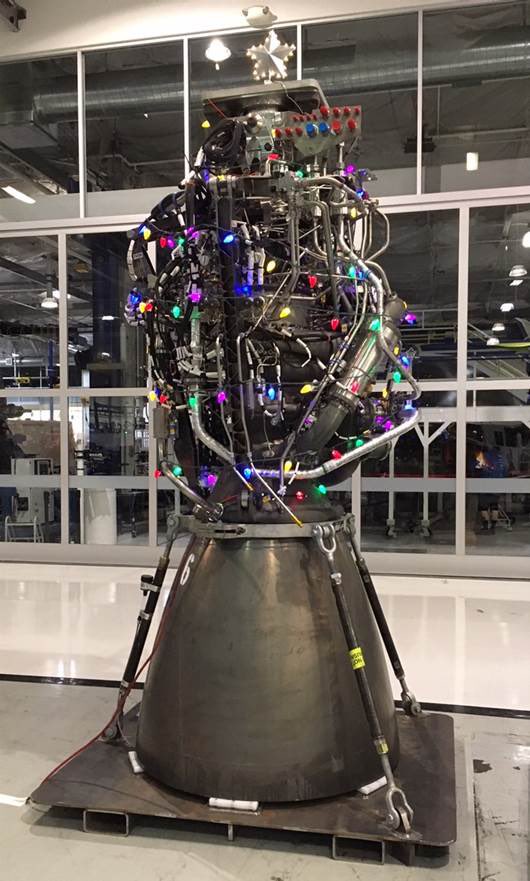SpaceX CEO Elon Musk showed off a holiday-themed Raptor engine “Christmas tree” with its very own star on top. Musk noted via a tweet that the company’s Starship propulsion team is “making great progress” building, testing, and refining the Raptor engines that will one day propel the next-generation rocket to Earth orbit and beyond.
On December 13th, Musk revealed that SpaceX is preparing to ship the 17th completed Raptor engine to the company’s McGregor, Texas rocket test and development facilities, the site of several dedicated test stands for the Starship engine. Likely one of the most complex rocket engines ever designed, built, or tested, Raptor relies on an exotic combustion cycle, referring to the specifics of how engines turn their propellant into meaningful thrust.
Raptor uses what is known as full-flow staged combustion (FFSC) and is the first FFSC engine to graduate beyond ground testing and actually fly, thus far having completed two flight tests in July and August 2019 as part of SpaceX’s Starhopper test campaign. In simple terms, the FFSC cycle aims to extract as much energy from a rocket’s propellant as efficiently as possible, resulting in what is theoretically the most efficient possible chemical propulsion from a given fuel and oxidizer combination.
Due to the sheer complexity required to achieve full-flow staged combustion, the engine type is incredibly rare and only two other (once) functional examples exist – one developed by Soviet engineers in the 20th century and the other built, tested, and inexplicably scrapped by NASA in the 2000s. In fact, the Soviet RD-270 engine’s thrust-to-weight ratio is likely second only to SpaceX’s own Merlin 1D engine, an absolutely spectacular achievement for a propulsion bureau operating in the late 1960s.
RD-270 had major development challenges and would likely have taken years of additional hardware-rich (i.e. destructive trial and error) testing to produce an engine actually capable of reliable flight. Before the program was cancelled in 1970, 22 engines were tested and no single RD-270 survived to perform a fourth static fire, a testament to the immense challenge of FFSC engines.

SpaceX appears to have had a much better go of it with Raptor, although many, many engines have definitely been destroyed or irreparably damaged since the full-scale engine’s February 2019 static fire debut. SpaceX CEO Elon Musk says that the 17th completed Raptor engine is almost ready to head to McGregor, Texas to kick off development and acceptance testing.
It remains to be seen when exactly Raptor engines will be mature and reliable enough to perform the 3-10 minute burns needed to send a Starship to orbit, let alone the Moon or Mars, but Musk appears confident that SpaceX is making great progress along those lines.
Per photos and info posted by NASASpaceflight.com earlier today, Raptor engine SN15 is already installed on a recently-reactivated McGregor test stand ahead of its first rocket-related test in almost half a decade.
Formerly used to test Falcon 9 first stages before SpaceX built a new stand for Falcon 9 and Heavy, that tripod stand has been reactivated for the sole purpose of supporting vertical Raptor engine static fire testing, which Musk says will simplify and expedite development by making test conditions much more flight-like. As of now, all subscale and full-scale Raptor engine static fire testing has been performed at horizontal test stands in McGregor, apparently resulting in wear and behavior that would not likely appear if engines were tested vertically.
SpaceX has gone through the same process with its Merlin engine programs, beginning with horizontal testing (far easier and simpler) but ultimately building a number of dedicated vertical test bays to ensure that engine acceptance and development tests can be performed under more flight-like conditions.

According to NASASpaceflight, SpaceX may have already fired up Raptor SN15 on its reactivated tripod test stand earlier this week, kicking off Raptor’s first Starhopper-free vertical static fire testing. It’s now unclear where the twin horizontal Raptor test bays will fit into future engine testing given Musk’s comments. More importantly, every completed Starship and Super Heavy rocket will require several dozen new Raptor engines and every one of those engines will likely need to pass acceptance testing (including static fires) in McGregor before they can be installed on a launch vehicle.
SpaceX’s Falcon 9 rocket already requires 10 engines per new booster and upper stage, a test burden SpaceX has only managed with the help of two Merlin 1D stands and one Merlin Vacuum stand, all vertical. In other words, it’s safe to say that the reactivated tripod stand is likely just the first of several vertical Raptor test stands to come.

Check out Teslarati’s newsletters for prompt updates, on-the-ground perspectives, and unique glimpses of SpaceX’s rocket launch and recovery processes.

(adsbygoogle = window.adsbygoogle || []).push({});
<!–
–>
var disqus_shortname = «teslarati»;
var disqus_title = «SpaceX's "Christmas tree" is a Raptor engine for the holidays»;
var disqus_url = «https://www.teslarati.com/spacex-starship-engine-raptor-milestone-festive-decorations/»;
var disqus_identifier = «teslarati-123224»;

